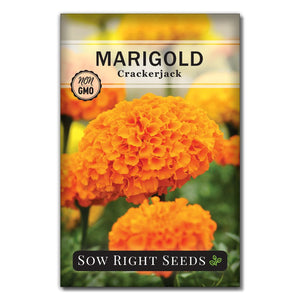How to Prevent Squash Vine Borers Before It's Too Late
PestsSquash vine borer is a stealthy pest. Even though you can clearly see the adults flying around, it is the larvae that invisibly bore into the stem of squash plants and ruin your pumpkin and squash harvest dreams. But don't despair, we’ll explain the squash vine borer lifecycle and the most common prevention tips to ensure a healthy harvest.

In our garden at Sow Right Seeds, we deal with the same common pests every gardener does. Each year is a little different. Last year, we had fewer problems with vine borers. We think some of this is due to the yellow bucket method we used. To help the rest of our gardening friends, we gathered all the methods gardeners use to prevent squash vine borers from devastating your squash and pumpkin plants.
Squash Vine Borer Life Cycle
Understanding the squash vine borer's life cycle can help you employ the right detection and prevention techniques for your garden. Depending on your location, there can be one or two generations of squash vine borers each year.
Adult vine borers will emerge from the ground in late spring or early Summer. You can check with your local extension to find out what month is typical in your area. Here in the Midwest, it’s usually late June to early July when you see the adult moths flying around. Their orange and black bodies are easy to identify. Even though they are technically a moth, they look like wasps.
When the adults emerge from the ground, they lay eggs at the base and along the stem of plants. Squash Vine Borer eggs are different from squash bug eggs. They are usually singular eggs, not a group, and also a different color.
Larvae hatch from the eggs in about ten days. Within hours of hatching, these hungry creatures will burrow into the vine and start feasting on the center of the stem. Squash Vine borer larvae will feed for four to six weeks, and when they are satisfied, they return to the soil where they pupate. They will then emerge the following summer as adults to lay eggs and start the process all over again.

Signs of Squash Vine Borer
The top three crops squash vine borers will target are pumpkins, zucchini, and summer squash. The first sign you may notice is wilted squash plants in the morning when they were fine the day before. Plants with a healthy vascular system usually only droop in the heat of the afternoon. So, morning wilt can signal a pest problem.
Once you notice wilting, look for holes at the base of the plant stem. You may see sawdust-like mounds that are green or orange. This material is called frass and is the telltale sign that the larvae are inside and starting to eat their way through.
Check to see if there is more than one hole, as there can be more than one larva in a plant. The damage caused by the larvae prevents the plant from distributing nutrients and water to the rest of the plant. Eventually, the whole stem will rot away, and the plant will die.

How to Prevent Squash Vine Borers
These annoying pests are difficult to prevent from entering your garden. Some locations naturally have more vine borers because of the local weather conditions and the crops growing in the area. If squash vine borers' favorite crops are available, they will thrive.
Not everyone has success with these prevention methods. It can depend on how infested your garden already is. However, we share these methods so that you can find what works best in your garden.
Row Covers
Row covers can help prevent vine borer moths from landing and laying eggs on the stems. However, if the moths are already under the cloth, they can lay eggs without flying to a new location. You will need to remove row covers when the plants are flowering or you will have to hand pollinate for fruit production.
Collar Barriers and Wrapping
One of the simplest vine borer prevention methods is to put a barrier around the plant stem. This method keeps the adult moths from laying their eggs there. Paper or plastic collars made from disposable cups can be placed around squash and pumpkin seedlings.
Wrapping aluminum foil or self-adhesive bandages around plant stems works for some gardeners. Always check for eggs before wrapping the stems.
Trapping Adult Squash Vine Borers
Trapping adults can help prevent the population from increasing. The yellow bowl method was beneficial for controlling squash vine borers in our Sow Right Seeds garden. It appears that squash vine borers have a preference for the color yellow. We took a yellow pan and filled it with water and a little bit of dish soap. The adult vine borers were attracted to the yellow pan. When they fell into the water, they couldn’t get out.

Wiping Eggs Off Stems
If you can find and destroy the eggs before they hatch, you will guarantee a squash vine borer-free season. But finding every tiny egg is an impossible task. As soon as you see the adults flying around, you can check the stems and leaves and wipe off any eggs you find. This may be difficult in large gardens, but in small plots with just a few susceptible plants, it may be worth the effort.
Plant Less Susceptible Plants
Some plants are less susceptible to vine borers. While pumpkins and zucchini are popular targets, Butternut squash and cucumbers are less likely to be attacked. One year, my summer squash plants succumbed to vine borers, but the butternut squash planted nearby grew all season.
Succession Plant
A 3-week gap between crops can ensure plants grow at different times and offset the time when adults would be laying eggs. You can also start seeds indoors and transplant them outdoors after the egg-laying season.
Change When You Plant
In some gardening locations, changing your planting schedule can pay off. Some gardeners have success by starting seeds indoors earlier. Starting seeds earlier indoors can give your squash plants a head start on producing fruit before vine borers emerge. Planting big, healthy seedlings outdoors as soon as possible gives them enough time to have a substantial harvest before squash vine borers kill the plants.
Planting as late as possible in the season can also be helpful if the vine borers have already returned to the ground.
Rotate Crops
If you have a terrible infestation, you can disrupt the vine borer life cycle by not planting any of their favorite crops for a year—instead, plant beans and peas and cover crops to replenish the soil. When the adults emerge, they won’t have their favorite plants on which to lay eggs. They will have to fly further away, and adult moths can fly up to 1300 feet.
Kill Pupae in the Soil
One method to prevent a new generation of squash vine borers is to kill the pupae in the soil. They are generally 1-6 inches down. Tilling the soil can uncover the pupae, or you can add beneficial nematodes at the right time.
Clean Up the Garden
Getting rid of vines that still have larvae or eggs on them can help disrupt the vine borer lifecycle. Burn or shred infested vines to destroy and help diminish next year’s population.

How Do You Get Rid of Squash Vine Borers Once They Are in the Vine?
Cut Out Larvae
You can cut squash vine borers out of the vine. The sooner you do this, the more likely the plant will recover. Make a small slice where the larva is and remove it. Then, put soil around the stem and water well to see if new roots will grow. If the damage is minor, the plants may recover. If the larvae have just started feasting, you can poke a needle into the hole and kill the worm.
Inject Poison
Any kind of pesticide or chemical application needs to be targeted at the right time. Bt and Spinosad are two options for injecting into the vine.
Let Plants Sprawl
This method doesn’t prevent squash vine borers, but it can allow the plant to continue growing after it has had vine borer damage. If there are multiple points of soil contact, the vines can grow more roots. This keeps the squash plant from only having one source of water and nutrients.
It can seem like there’s always trouble brewing in the garden. The Yin and Yang of growth and destruction are always at play. But winning is possible when you focus on healthy growth and keeping pests away.
Start early and take the protective measures needed to prevent squash vine borers from destroying your zucchini, pumpkin, and squash harvest.
And let us know what methods have worked for you!








My squash plants were fine last year. I removed 6 larvae yesterday and four more today from my plants. The bush varieties are a complete loss. I’m hoping the candy roaster plants will survive.
Vine borer problem has been way worse since I went no-till.
Thank you for the helpful information. I lost all my zucchini last year but this article is most definitely going to help my battle this year!
Leave a comment